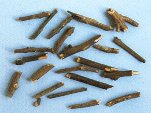Cinnamon Twig
http://www.100md.com
《e Natural Health Center》
 |
 |
 |
 |
Herbs for Dispelling Wind and Cold
Cinnamon Twig
Latin:
Ramulus Cinnamomi
Origin:
The species Cinnamomum zeylanicum is the bushy evergreen tree of the Lauraceae family, native to Sri Lanka (Ceylon), the neighbouring Malabar Coast of India, and Myanmar (Burma), and also cultivated in South America and the West Indies for the spice consisting of its dried inner bark. The spice is light brown in colour and has a delicately fragrant aroma and warm, sweet flavor.
, http://www.100md.com
Cinnamon was once more valuable than gold. In Egypt it was sought for embalming and witchcraft; in medieval Europe for religious rites and as a flavoring. Later it was the most profitable spice in the Dutch East India Company trade.
In modern times, cinnamon is used to flavor a variety of foods, from confections to curries; in Europe and the United States it is especially popular in bakery goods. In China, it is used as a decongestant herb to relieve exterior syndromes.
, http://www.100md.com
The Chinese herb cinnamon twigs are mainly produced in Guangdong, Guangxi and Yunnan. The twigs are often cut in spring, exposed to the sun for a time, dried in the air and cut into slices or sections for use.
Properties:
Pungent and sweet in flavor, warm in nature, it is related to the heart, lung and urinary bladder channels.
Functions:
, http://www.100md.com
Inducing sweat and relieving external symptoms; warming the channels to ensure the flow of the yang-qi.
Applications:
1. Cinnamon twigs are used to treat common colds due to pathogenic wind-cold.
2. Often used together with licorice for the treatment of palpitation, precordial pains and slow and irregular pulse due to asthenic heart qi; often employed in conjunction with large-headed atractylodes rhizome, tuckahoe and licorice for the treatment of cough due to retention of phlegm, dizziness and palpitation due to deficiency of yang qi in the heart and spleen; for the treatment of arthralgia due to wind-cold-dampness; menostasis (stoppage of the mences) due to cold and dysmenorrhea (difficult and painful menstruation); and dysuria (painful or difficult urination) and edema due to the loss of control of the bladder-qi.
, 百拇医药
Dosage and Administration:
3-10 g.
Decoction.
Cautions on Use:
1. It should be avoided by those with external symptoms of excess caused by exopathogenic wind-cold.
2. Its use is forbidden for those with external symptoms caused by exopathogenic wind-heat such as thirst and taut and rapid pulse, despite aversion to wind and spontaneous perspiration.
, http://www.100md.com
3. To be taken with care by pregnant women and those with menorrhagia.
Reference Materials:
Toxic or Side Effects:
Modern Researches:
Cinnamon contains from 0.5 to 1 percent essential oil, the principal component of which is cinnamaldehyde. The oil is distilled from the twig fragments for use in food, liquor, perfume, and drugs. The aldehyde can also be synthesized.
, http://www.100md.com
Functions of cinnamaldehyde:
1. Cinnamaldehyde has tranquilizing, pain-killing and convulsion-resistant properties. Injecting cinnamaldehyde into the abdominal cavity of a mouse can alleviate the body sprain reaction caused by acetic acid. The use of the dosage of 500 mg/kg can resist tonic convulsions caused by strychnine.
2. Acts to reduce fever induced in rabbits in experiments.
3. Relieves coughing and induces diuresis., http://www.100md.com